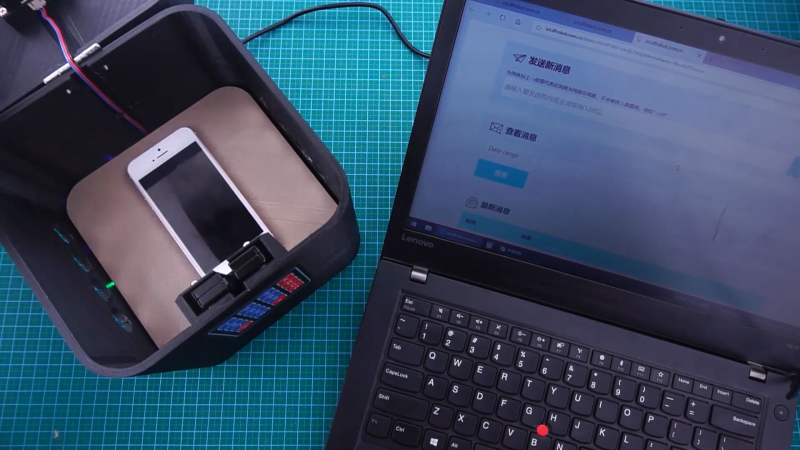Phones are pretty great. Used as telephones, they can save us from bad situations and let us communicate while roaming freely, for the most part. Used as computers, they often become time-sucking black holes that can twist our sense of self and reality. Assuming they pick up when you call, phones are arguably a good thing for kids to have, especially since you can hardly find a payphone these days. But how do you teach kids to use them responsibly, so they can still become functioning adults and move out someday? [Jaychouu] believes the answer is inside of a specialized lockbox.
This slick-looking box has a solenoid lock inside that can be unlocked via a keypad, or remotely via the OBLOQ IoT module. [Jaychouu] added a few features that drive it out of Arduino lockbox territory. To prevent latchkey children from cheating the system and putting rocks (or nothing at all) in the box, there’s a digital weight sensor and an ultrasonic sensor that validate the credentials of the contents and compare them with known values.
Want a basic lockbox to keep your phone out of reach while you work? Here’s one with a countdown timer.
















Wouldn’t it be possible to put a short charging cable inside and attach that to a host port so you can retrieve some sort of ID when the device is plugged in? Would save one from having to guesstimate what’s in the box by taking measurements… might be my approach when I need to implement this in a couple years for my kids :-)
NFC might also work on newer phones, but in any case, a built in charger would be a must have. Also, the kids would have a (timer controlled) access code only they know because having your own secret code is awesome.
Usually the phone will require authentication to enable the USB port for data transfer. And depending on phone configuration, IDs might not be available.
I would suggest NFC instead. All phones, both iPhones and Androids, have RFID capability. And even if no payment app is installed, the NFC reader will still spit out a Mifare UID, which you can store, as validation the right phone as been placed. This is whats used in professional “loan mobile” cabinets. You could combine that with a charger which validates there is a specific minimum current draw before it “accepts” the phone.
The NFC reader is usually online even if you haven’t authenticated, sometimes you need to just unlock screen but you don’t need to permit or authenticate data transfer – if the NFC reader is not “opened” for payment of use, it will still function and give out its UID.
I would Install loose-leaf inside the box… Kids are smart enought to pickup a screwdriver
What kind of child is not able to unscrew the 2 screws on the back to access the box?
so you have this awesome creation of technology, that has its own operating system which allows you to do various tasks, of which limiting access and logging the use of is possible STRAIGHT FROM THE MANUFACTURER, and yet you want to lock it in a box…
Keep in mind that the phone makes a great inconspiquous tracking device, so if the kid has it at him at all times despite not being able to abuse it, it’s great failsafe for bad situations or just to keep track of him instead of having the phone and the kid separate from each other.
Nice but… do you know that kids can use SCREWDRIVERS to open boxes, right? :) #lol
naw what you should do is lock it down in software but whitelist 911 and family numbers for emergencies.
over half of this summary is telling us what benifits a modern phone has before even mentioning the hack, good job
Technological solutions for people issues are never actually good solutions for what they try to solve. Why not actually be a parent and talk to your kids about responsible usage instead of trying to keep them safe through obscurity? It didn’t work with the generation many if not most Hackaday readers belong to – attempts to keep young people off the internet or to actively police their usage hamper communication and feelings of personal security and have only ever served to build resentment between child and parent. Prohibition doesn’t work for what it’s (allegedly) used for. The actual answer is to talk to kids like they’re adults.
It’s a neat device even if it’s intended purpose is quite frankly bad. It’s more useful for an environment where you have sensitive equipment that needs to be signed in and out. That eliminates paper usage and makes it harder to forge. A pager phone for on-call rotations, walkie-talkies in a locker, etc. There’s enough support for key fob readers around that they’d be an easy integration, too.
Aren’t there “Parent Control” apps on the market? If there are what use is this and if there aren’t I just gave someone a million dollar idea.
I think this falls under the old how to solve a software problem with hardware adage.